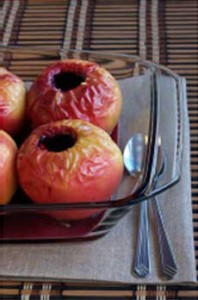TIP OF THE DAY: Diet Baked Apples
|
|
When you’re trying to cut back, dessert is the trickiest course to navigate.
Personally, we avoid all “reduced calorie” versions of fattening desserts. It’s better to have a small piece of the good stuff less often, then it is to have “light” versions of brownies,, cheesecake, etc. One of our go-to healthy desserts is a baked apple, made with non-caloric sweetener or low-glycemic agave syrup. It couldn’t be easier. Use the apples you prefer for apple pie—varieties that hold their shape when cooked. Some examples include the Baldwin, Crispin/Mutsu, Granny Smith, Honeycrisp and Pink Lady. You can bake them or microwave them. Microwaving is faster, and is the ideal way to cook a single serving. But if you become a fan of these baked apples, try baking them to see if you prefer the consistency. |
|
|
RECIPE: DIET BAKED APPLES Ingredients (e.g. Cheerios or raw oats), yogurt 1. CORE the apples and place them in a microwave-safe dish in a half inch of water. 2. SPRINKLE the cored inside liberally with Splenda, cinnamon and nutmeg. Be sure the apple skin and the water are also sprinkled. The water will turn into a sort of syrup. 3. MICROWAVE for 3-1/2 to 4 minutes or until tender. Microwave ovens vary, so test until you find the right texture. Sometimes we want an al dente baked apple; other times we cook it longer to achieve the consistency of hot applesauce. 4. OPTIONAL: Reduce the cooking water to be more syrup-like. If you’re using agave, you can flavor the syrup with cinnamon and other spices. When ready to eat… 5. GARNISH as desired and serve. PREHEAT the oven to 375°F. Bake the apples, basting with the pan liquid every 5 to 7 minutes, until tender (45 minutes to an hour). |
||
|
THE HISTORY OF APPLES
Apples seem like the quintessential European fruit. But they first grew wild in the Tien Shan mountains of Kazakhstan, in Central Asia, millions of years ago. Those early apples were likely smaller and more sour than modern apples—more like crabapples. By about 6500 B.C.E., travelers were carrying cultivated apple seeds west, to West Asia, and east to China. Charred remains of apples have been found at a Stone Age village in Switzerland. (The Stone Aged spanned 6000 B.C.E to 2000 B.C.E.) [Source] By the third century B.C.E., the Greeks were growing several varieties of apples; the ancient Romans also grew and loved the fruit. Around 100 C.E., the Roman Legions brought apples along as they advanced north through Europe. Gaul (ancient France) became a fertile region for apple cultivation. The Romans also planted apples in Brittania (England). Centuries later, following the Norman conquest in 1066, new varieties of apple from France were introduced to England. |
|
|
|
Apples were a boon to Europeans. They ripened just as it was getting cold and they could keep all winter, a valuable food source when nothing else was growing. Apples were also sliced, dried and stored. And bitter varieties were pressed to make cider. The word “apple” comes from the Old English word, “aeppel.” Cognates appear in Dutch, Old Frisian, Old High German and Old Saxon. According to What’s Cooking America, there are approximately 10,000 different kinds of varieties of apples grown around the world with more than 7,000 of these varieties grown in the U.S. (only a fraction are grown commercially). Apples arrived in the New World in 1607, with the Jamestown settlers. The seeds and cuttings they brought from Europe were not all suited for cultivation in Virginia, but they began to mutate to new varieties of American apples. Many of these apples were fairly bitter—not hand fruit, but important for making cider, which was more valuable than hand fruit or cooking fruit. Most early colonists grew their own apples. Due to unhealthy water sources, most people, including children, drank beer or hard cider instead of water (the same was true in Europe). Apples were being grown in Massachusetts as early as 1630. Mutation was continually creating new breeds. The McIntosh mutation was discovered in 1796, by a farmer named John McIntosh. Sweet apples for eating were grown as well, and today they’re grown in every state. Thomas Jefferson had a part in the development of the Fuji apple. As the story goes, the French minister to the United States gave Jefferson a gift of apple cuttings; Jefferson donated them to a Virginia nursery which cultivated them as the “Ralls Genet.” In 1939, Japanese apple breeders crossed the genes from the Red Delicious apple with the Ralls Genet, resulting in the now-ubiquitous Fuji apple. [Source] |
||

